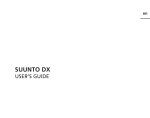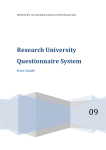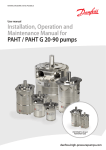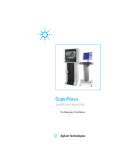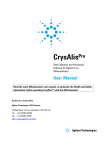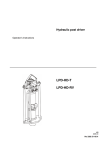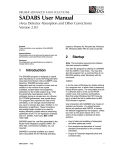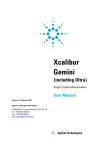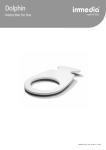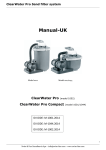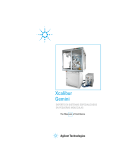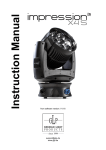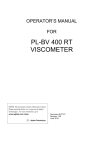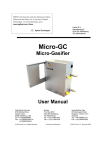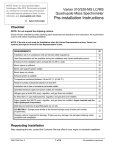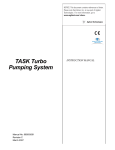Download PX Scanner™ SuperNova™
Transcript
PX Scanner + SuperNova driving X-ray innovation PX Scanner™+ SuperNova™ Unique In-situ X-ray and Optical Imager Highest Quality & Reliability Protein System PX Scanner + SuperNova PX Scanner The PX Scanner is Oxford Diffraction’s unique instrument for the X-ray screening of protein crystals, in-situ in the multi-well crystallisation plate. A combined optical imager and X-ray system, the PX Scanner allows the visualisation, identification and X-ray evaluation of protein crystals undisturbed within the growth media. Benefits of the PX Scanner Early stage identification of crystalline material Discrimination of salt from protein crystal Identification of optimal crystal growth conditions An unlimited number of crystals can be queued for X-ray analysis, either within one well or over an entire plate. The PX Scanner then automatically processes the queue, leaving the user free to continue with other crystallisation work before reviewing their diffraction results. Comparison of crystal diffraction quality Automated crystal screening leading to accelerated results Study of crystals too small and fragile to extract By removing the manual handling of potential crystals during screening, the PX Scanner can accelerate the study of crystals at all stages of the crystallisation work flow, including: Phi Axis Having identified a suitable crystal using in-situ diffraction, the crystal can then be extracted from the well and mounted atop the Phi Axis. Accepting protein crystals in either loops or capillaries the Phi Axis attachment is inserted into the front of the PX Scanner and allows full X-ray data collection. The Phi Axis has a rotational range of up to 360 degrees and a resolution limit of up to 2.0Å High throughput crystallisation condition screening and Crystallisation scale-up for diffraction crystals Multi-well crystallisation plate and Phi Axis Applications Optical and in-situ screening Comparison of crystal diffraction quality Small, fragile crystals Structure determination Screen sensitive, membrane proteins The complete PX Scanner system including monitor / keyboard table PX Scanner + SuperNova PX Scanner The System The PX Scanner is unique as the world’s only commercially available system for in-situ X-ray screening of protein crystals. Specially designed for this purpose, the PX Scanner is a compact system occupying a footprint of approximately 0.5m2 (not including separate monitor table). Contained within a fully interlocked radiation proof cabinet, the PX Scanner consists of an x-y-omega goniometer table and crystallisation plate carriage, a high intensity X-ray source and a 165 mm diameter, large active area CCD detector. Entirely self contained, the PX Scanner requires only a low power mains electricity and water supply, having a built in control computer, system interface, X-ray generator and compact internal chiller units. For ease of integration into high throughput research laboratories, the PX Scanner comes complete with a dedicated barcode reader allowing the quick and easy identification of the plate prior to loading. PX Scanner - Loading a crystallisation plate View inside the PX Scanner showing the: Optical imaging The x-y-omega goniometer table positions the crystallisation plate beneath a series of digital microscopes and cool LED lights for optical imaging of the droplets within the well. Using Oxford Diffraction proprietary algorithms, a series of optical images are recorded of differing focal depth and lighting. A single optimised composite image results. In-situ X-ray imaging Housed within the base of the system the high intensity Nova™ X-ray source is orientated to provide a vertical X-ray beam. Having optically imaged the plate and a potential crystal selected for in-situ X-ray study, the plate and crystal are accurately positioned directly over the X-ray beam which shoots vertically up through the horizontal plate and crystal. The plate and thereby crystal can be tilted up to 6° using the goniometer, allowing scanned X-ray images to be collected. The diffraction data is collected above the plate by an Oxford Diffraction 165 mm CCD detector. Plate compatibility Highly versatile, the PX Scanner accepts virtually all crystallisation plates, micro-fluidic chips and counterdiffusion set-ups which fully conform to SBS format. X-ray safety panel System interface System computer X-ray generator X-ray and CCD chiller PX Scanner + SuperNova SuperNova As the latest protein diffraction system from Oxford Diffraction, the SuperNova is compact and easy to use, providing the highest quality crystallographic data from a system of the highest reliability. SuperNova is the ideal companion to the PX Scanner. Together the two systems provide all you need for the complete protein crystallography laboratory. Kappa platform With its 4-circle kappa goniometer, the SuperNova is ideally suited for fast, strategy based data collections as well as high resolution, in-house phasing experiments. The kappa goniometer incorporates a motorised sample to detector distance for the study of large cell proteins and a rotatable beam stop for ease of crystal mounting using cryo-tools. The SuperNova combines Oxford Diffraction’s high intensity Nova X-ray micro-source with the 165 mm fast, high performance Titan™ CCD detector. Mounted on a 4-circle goniometer, the copper radiation Nova X-ray source provides up to 3x the intensity of a 5kW rotating anode generator with optics and the data quality of a micro-focus rotating anode. Occupying a 0.5m2 footprint, the SuperNova’s stylish design of safety interlocked and radiation proof cabinet is entirely self contained and incorporates the X-ray generator, system interface, system computer and two compact water chiller units. For installation, the SuperNova requires only a low power mains electricity and water supply. Ease of sample mounting on the SuperNova. Configuration shown includes the optional second wavelength X-ray source Optional Cryo-devices The SuperNova goniometer has been designed to accept all major open flow cryogenic sample cooling devices, including Oxford Diffraction’s liquid nitrogen device (90 - 300K). Applications Molecular Replacement (MR) Screening Ligand binding SAD Phasing or Heavy Atom Phasing Small Molecules Highest Quality & Reliability The complete SuperNova system including monitor / keyboard table and optional cryo-device PX Scanner + SuperNova SuperNova Nova X-ray Micro-source The SuperNova has been designed around the low power consumption yet high intensity Nova X-ray micro-source. Up to 3x more intense than a 5 kW rotating anode and with more than 30 systems installed, the Nova is the best selling, most reliable micro-source from any manufacturer in single crystal X-ray diffraction. The Nova combines a state-of-the-art multi-layer optic with a micro-focus X-ray tube running at 50W. Power to the Nova is provided by a software controlled X-ray generator mounted in the base of the SuperNova system. Copper wavelength, 50W X-ray micro-source Multi-layer X-ray optic Up to 3x more intense than a 5kW rotating anode with optic Approximately 300 micron beam size View of the SuperNova goniometer Titan CCD Detector Atlas CCD detector The SuperNova incorporates Oxford Diffraction’s high performance, fast CCD detector, Titan. At 165 mm in diameter, the Titan is the largest single chip CCD detector available today and is ideal for high resolution protein data collection using fine slicing. For studies requiring higher sensitivity combined with large active area, the SuperNova can be configured with the 135 mm Atlas™ CCD. Multi-layer optic inside Nova X-ray source Active area Ø165 mm Gain, 24 e-/X-ray (Cu) Precision, 18 bit Speed, 0.28 sec (duty cycle) Low noise Active area Ø135 mm Gain, 65 e-/X-ray (Cu) Precision, 18 bit Speed, 0.28 sec (duty cycle) Low noise PX Scanner + SuperNova SuperNova CrysAlisPro Software The SuperNova comes complete with CrysAlisPro™, Oxford Diffraction’s intelligent data collection and data processing software for protein crystallography. Designed around an easy to use graphical user interface, CrysAlisPro can be operated under fully automatic, semi-automatic or completely manual control. AUTOMATIC CRYSTAL SCREENING At the heart of CrysAlisPro are the automatic crystal screening and data collection strategy software modules. For a typical crystal, a pre-experiment lasting less than 5 minutes is recorded to evaluate the crystal quality. From the first frame of data, CrysAlisPro automatically evaluates the crystal quality and provides the user with information regarding the unit cell, angular resolution and suggested frame exposure time. Automatic and concurrent data reduction Data reduction and processing initialise automatically with the start of data collection and intelligent routines tune the parameters for the best data quality. Since data reduction is concurrent with data collection, processed data are always available and accompanied by real time on-screen feedback of data quality and completeness. Specialist crystallographic tools In addition to the automatic routines, CrysAlisPro provides hundreds of specialist tools and functions for dealing with non-standard and problematic crystals, including: Single image screening Advanced unit cell finding Reciprocal space viewer Space group determination Twinning Remote device control (X-ray generators, Cryo-devices) Fastest Strategy software Following the pre-experiment, the sophisticated CrysAlisPro strategy software automatically calculates the optimal data collection conditions for fast, high quality, complete data. All strategies are calculated based on the specific crystal orientation and unit cell and the user has complete control to optimise the data collection for a wide variety of targets including multiplicity, time and resolution. Strategy calculations are extremely fast and efficient allowing the user to quickly adapt the data collection conditions. Axial photos Compatibility and software licences CrysAlisPro automatically outputs data in MTZ format and interfaces seamlessly with the CCP4 suite and third-party data reduction packages including MOSFLM, XDS and HKL2000. CrysAlisPro is provided with the SuperNova under a multi-site, multi-user licence. Main CrysAlisPro GUI PX Scanner CrystalEyes Software Once the multi-well plate has been loaded, user interaction with the PX Scanner is entirely via the CRYSTALEYES™ software. Easy to use, graphical interface CRYSTALEYES can be used online to control the PX Scanner or offline for the review of previously recorded data. The easy to use graphical user interface (GUI) uses a schematic of the crystallisation plate for user selection of wells. Dependent upon the type of plate, one or more drops are displayed, together with a list of all data recorded, be it optical or X-ray. The user can then select any part of this data for display as a large image within the GUI. Optical imaging Using CRYSTALEYES the PX Scanner can optically image either the entire plate or individual user selected wells / drops. All tasks are added to an on-screen queue allowing the PX Scanner to be used either in real time manual mode or unattended automatic mode. Mouse selection of objects for X-ray Whilst reviewing optical images, objects for in-situ X-ray are easily added by simply clicking on the object using the mouse cursor. The software automatically queues the task, centres the crystal on the X-ray beam and collects data. Once recorded, X-ray images can be analysed within CRYSTALEYES to provide the following information: Angular resolution limit of diffraction Ease of export of results All results from CRYSTALEYES can be exported as a concise html report with more in depth crystallographic analysis available using Oxford Diffraction’s CrysAlisPro software. Phi Axis software CRYSTALEYES supplies a simple step by step guide to Phi Axis data collections, including: Crystal mounting and alignment using the PX Scanner’s video microscope Crystal screening for evaluation of the unit cell Automatic strategy based data collection Automatic and concurrent data reduction and finalisation Possible unit cell parameters Main CRYSTALEYES GUI in plate mode Secure login and data storage CRYSTALEYES operates a sophisticated, custom database which uses secure user login to control access to personal and group data. CRYSTALEYES GUI in Phi Axis mode 1500 mm 1650 mm LT Option 110-240 v drain water supply 110-240 v Vacuum pump drain water supply Vacuum pump 110-240 v Suggested system layout (in mm) 110-240 v System dimensions LT Option 470 Monitor Electronics Ø400 790 Monitor SuperNova 790 PX Scanner 710 130 710 Keyboard Keyboard Table 1000 570 door 100 510 Table 500 570 door 100 510 500 790 mm 670 mm 810 mm Environmental requirements for each system Power 240 /110 V (switchable) ± 10% / 16 A fuse protected Water 2 l/min flow required / 3 -5 bar gauge / 10 – 20 °C range / drain required Relative Humidity <80 % non-condensing Weight loading Able to bear system weight of 300 kg Temperature 18 – 23 °C Please refer to the system user manual for the most up to date and complete requirements. For more information on Oxford Diffraction or its products please contact us at: [email protected] Please refer to the system user manual for the most up to date Europe UK: +44 (0)1235 443630 North America: +1 540 443 9272 Latin America: +1 540 443 9272 and complete requirements Asia Pacific Hong Kong: +852 2571 9188 For other sales offices and dealers throughout the world - please visit our website at: www.oxford-diffraction.com or www.varianinc.com Chromatography • Spectroscopy • Mass Spectrometry • Magnetic Resonance Spectroscopy and Imaging • X-Ray Crystallography • Dissolution • Consumables • Data Systems • Vacuum Oxford Diffraction reserves the right to change product specifications without notice. © Oxford Diffraction Ltd, 2008. All trademarks, copyrights and registrations acknowledged. All rights reserved. Printed by Real Affinity Agency in England. SI-1617/A/07/08












